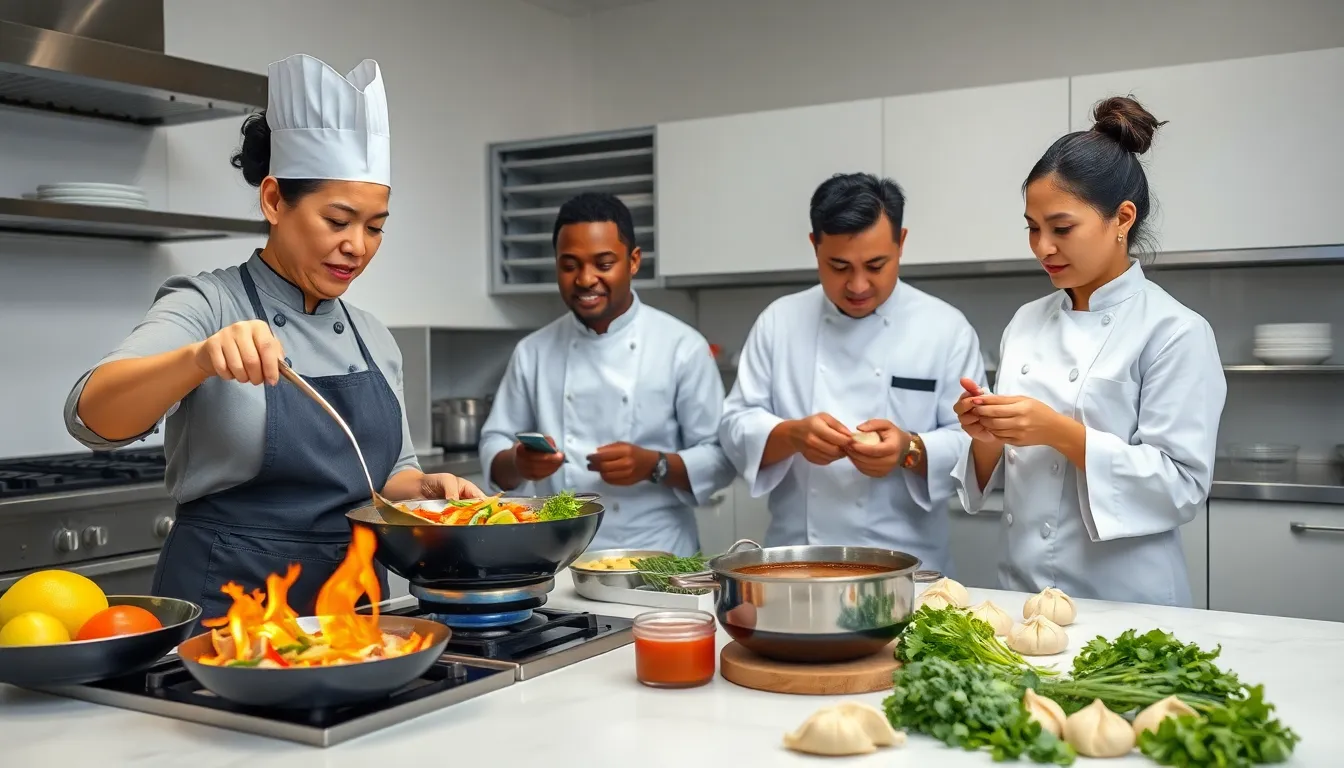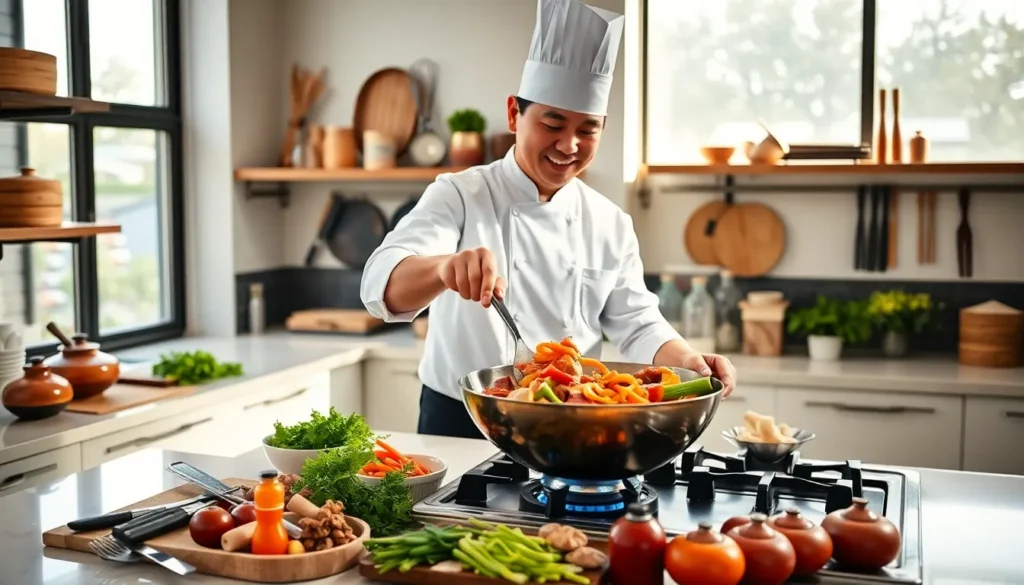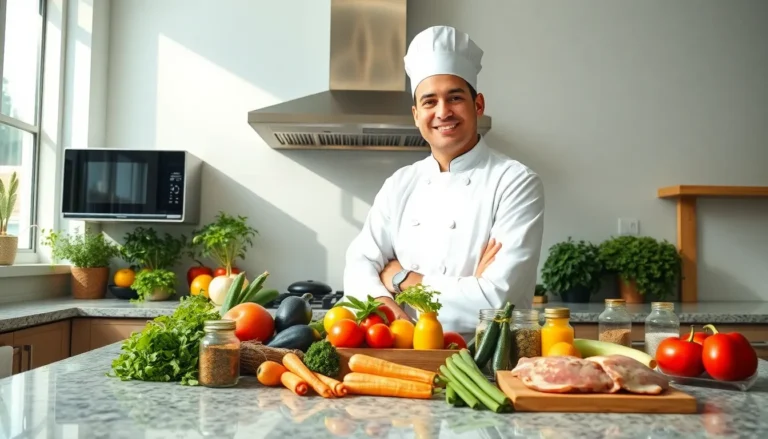Table of Contents
ToggleWhen it comes to culinary mastery, few cuisines rival the depth and diversity of Chinese cooking techniques. If the thought of creating mouthwatering stir-fries or delicate dumplings doesn’t make your taste buds tingle, what could? Believe it or not, mastering Chinese cooking isn’t just about the ingredients: it’s about the techniques that create those unforgettable flavors. Stick around, because this flavorful journey will spice up your kitchen skills, and your dinner table.
Overview of Chinese Cooking Techniques

Chinese culinary techniques are a prodigious blend of tradition, culture, and practical savvy. This ancient cuisine showcases diverse cooking styles, often influenced by regions. Techniques stretch from quick stir-frying to slow braising, presenting a spectrum of flavors and textures. All meals generally pay homage to the balance of taste, color, aroma, and texture.
The use of cooking methods is not random: each serves a purpose tailored to enhance the dishes. A quick lesson in these techniques will enable aspiring chefs to unlock the intricate world of Chinese cuisine.
Stir-Frying
Stir-frying reigns supreme in Chinese cooking, capturing a world of flavors in mere moments. This technique involves cooking food quickly over high heat in a wok, offering a brilliant combination of searing and steaming.
Vibrant vegetables and succulent proteins mingle under the flick of a wrist, transforming fresh ingredients into an artful masterpiece. With this method, the goal is to minimize cooking time while maximizing flavor. The use of a wok, with its curved shape, promotes even heat distribution and allows for tossing ingredients with grace, making stir-frying as much about finesse as it is about flavor.
The process begins by heating oil until it’s shimmering before introducing the ingredients. Aromatic ingredients like ginger and garlic take center stage, creating a fragrance that dances through the air. Then, proteins follow, quickly stir-fried to retain their juiciness, only to be joined by colorful vegetables in a crescendo of culinary delight. Season it all with soy sauce, sesame oil, or perhaps a dash of oyster sauce, and perfection follows.
Steaming
Steaming stands as one of the healthiest Chinese cooking techniques. This method, which involves cooking food over boiling water, preserves nutrients and leaves ingredients tender yet crisp. Dim sum, one of the most famous steamed dishes, showcases this technique beautifully.
Bamboo steamers are often used, laying the delicate dumplings and buns inside for a swift steam bath. The result? Tender morsels infused with the essence of their fillings. Steaming is also employed for fish and vegetables, allowing flavors to shine without the interference of heavy oils or unnecessary fats.
Choosing the right ingredients will make all the difference. Fresh seafood, vibrant greens, and expertly-seasoned meats shine when treated to the gentle embrace of steam.
Braised Cooking
Braised cooking is a slow-paced technique that embodies comfort and rich flavors. This process involves searing ingredients at high heat followed by a long simmer in a flavorful liquid. Beef bourguignon might steal the spotlight in French cuisine, but in Chinese kitchens, dishes like red-cooked pork (hong shao rou) or braised chicken highlight the art of braising.
Slowly cooking allows flavors to meld and deepen. Using a mix of soy sauce, rice wine, star anise, and ginger, a delightful symphony of taste emerges. Over time, the meat becomes tender, absorbing the rich flavors from the broth while the sauce thickens to form a velvety glaze.
Braising illustrates the magic of patience, producing dishes that provide heartwarming nourishment and leave lasting memories at the dining table.
Deep-Frying
Deep-frying is where indulgence meets technique. With its crispy exterior and juicy interior, deep-frying transforms ordinary ingredients into irresistibly crunchy bites. Chinese cuisine showcases this method in popular dishes like spring rolls and fried wontons.
The secret lies in the oil temperature: too low, and the food soaks up grease, too high, and it burns. Perfectly executed, the result is golden perfection. Breaded or batter-dipped ingredients benefit from a swift plunge into hot oil, creating an enticing crunch that pairs brilliantly with sauces.
Braising and Red Cooking
It’s essential to note the interplay between deep-frying and braising in Chinese cooking. While deep-frying provides instant gratification, braising rewards diners with flavorful depth. In some cases, meats might first be braised before a quick fry, producing layers of flavor.
Roasting Techniques
Roasting in Chinese cuisine adds another layer to the culinary tapestry. Famed for dishes like Peking duck, roasting infuses meat with a rich smoky flavor while crisping the skin to perfection.
Customized techniques can vary between regions but often share a common trait: a marinade to enhance flavor. Ingredients such as maltose are used to achieve that signature glaze, elevating roasted meats to a gourmet experience.
Use of Wok in Chinese Cooking
The wok is an unsung hero in roasting as well. In rural areas, it might be used for roasting whole animals over an open flame, while urban kitchens prefer circulating hot air to ensure even cooking. The versatility of the wok extends to numerous Chinese cooking methods.








